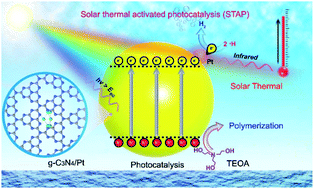Solar thermal-activated photocatalysis for hydrogen production and aqueous triethanolamine polymerization†
Abstract
The photocatalytic process plays a vital role in the direct conversion and storage of renewable solar energy into green hydrogen (H2) fuel, a long-term and sustainable technology pathway with the potential for limiting the growth of global carbon emissions. However, the kinetics of H2 production and photogenerated hole reactions are sluggish, which limit the intrinsic photoelectrochemical attributes of semiconductor materials, thus lowering the conversion efficiency of solar energy. Herein, we report a heterogeneous solar thermal activated photocatalysis (STAP) strategy for H2 production and triethanolamine (TEOA) polymerization initiated by highly active photogenerated electron–hole pairs. Under simulated solar light irradiation, solar thermal activation elevated the reaction temperature up to 40.7 °C with a 76.7 mmol g−1 h−1 photocatalytic H2 evolution (PHE) rate, which was 6.31 times faster than that at 11.1 °C (12.16 mmol g−1 h−1), ascribed to the solar thermal energy promoting H2 desorption from the surface of platinum (Pt)-deposited graphitic carbon nitride (g-C3N4/Pt). The detailed DFT calculations reveal that the solar thermal energy contributes significantly to activating the H2 desorption kinetics by reducing the energy barrier (ΔGD) of H2 desorption from the Pt-carbon nitride (Pt-CN) active site and diminishing the bond-dissociation energy (kcal mol−1) of the Pt–H bond. Furthermore, the STAP-optimized g-C3N4-T/Pt improved the PHE rate up to 92.1 mmol g−1 h−1, which was close to the level of commercial TiO2 (P25) at 104.0 mmol g−1 h−1. Besides, we also found that STAP facilitates aqueous TEOA polymerization, thus favoring the high-efficiency utilization of excited-state holes toward mediating green synthesis.

- This article is part of the themed collection: Journal of Materials Chemistry A Emerging Investigators


 Please wait while we load your content...
Please wait while we load your content...